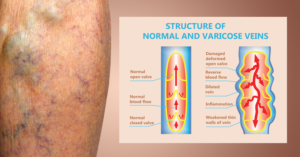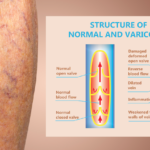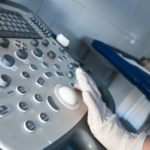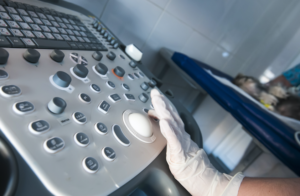 Our circulatory system is an amazing mechanism. Veins run throughout our entire body. They feed blood to every organ and cellular tissue. When veins sustain damage from trauma or vein disease – venous insufficiency they begin stages of venous insufficiency.
Our circulatory system is an amazing mechanism. Veins run throughout our entire body. They feed blood to every organ and cellular tissue. When veins sustain damage from trauma or vein disease – venous insufficiency they begin stages of venous insufficiency.
Damage to valves along with pooling blood is the cause of varicose veins. Though varicose veins are sometimes thought of as a cosmetic issue the effects can be medical as well. Varicose and damaged veins can lead to leg pain, swelling, ulceration, itching, aching, and even death of areas of flesh due to decreased circulation.
Even if you know the basics, we thought we would share some interesting vein facts that you might not know:
- Veins are more defined during strenuous exercise. This is due to increased arterial pressure. Blood that would normally be resting in capillaries during a work out is now forced into the surrounding muscle. This is what is known as a “pump”.
- One of the very first drawings of vein disease was on a tablet dating back to the 4th century in Greece. The carving shows a man gripping a disembodied leg with a big bulging vein on it.
- The human body can form new pathways and vessels if one becomes blocked! The process is called angiogenesis. This is the way that your body heals if you get a cut or scrape. Your body will compensate for the lack of blood flow in any way that it can. It is best though to seek medical attention if you notice that you have problems with varicose veins. The sooner you seek treatment, the better, less invasive, less expensive, and better the prognosis will be.
- Strong veins are essential – your heart depends on your veins for nourishment, as does every other organ. If your veins are too weak to get the blood where it goes it can cause pooling, discoloration, and even wounds that are very tough to heal.
- Pre 17th Century doctors believed there were two blood systems – one where the liver was the organ pumping the blood and another which carried air from the lungs and blood to tissue. It wasn’t viewed as circulating but more of an ebb and flow. It was not until 1682 that Dr. Wiliam Harvey first correctly outlined what our circulatory system actually does and how it works.
You may not be obsessed with anatomy history and facts the way that we are, but we do hope you found this interesting!
If you are looking for a cardiologist or Vein Specialist in the Tampa, Florida area we invite you to visit WWW.TAMPACARDIO.COM or give us a call to set a consultation by calling 813-975-2800.


 Are you experiencing symptoms?
Are you experiencing symptoms?